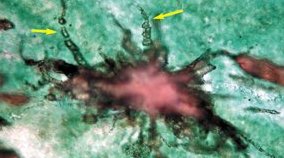Hints of Life in Ancient Lava
Ancient lava may contain some of the earliest traces of life on Earth.
By Emily Sohn
When you hear the word “lava,” your first thought might be of volcanoes violently spewing molten rock. Lava is full of surprises, though. Scientists now say they have found old lava that contains some of the earliest traces of life on Earth.
 |
|
The narrow structures (arrows) riddling this ancient seafloor lava may have been created by microbes almost 3.5 billion years ago. Colors correspond to different minerals. |
| Science |
Researchers from Norway and Canada dug lava samples out of rocks in South Africa. The samples are between 3.48 and 3.22 billion years old. Back then, oceans covered the areas where the samples were obtained.
The lava probably oozed out onto the ocean floor when two plates of Earth’s crust moved apart. When that happens, water quickly cools and hardens the ooze into rounded formations called pillow lava. Marine microorganisms soon settle in, feeding off of chemical energy in the lava.
One sign that tiny critters may have lived in the South African samples showed up under the microscope. In the outermost centimeter of lava, the researchers saw tiny tubular structures amazingly similar to those formed by microbes today. X-ray analysis of different types of carbon atoms inside the tubes also suggested the long-ago presence of life.
It’s exciting to find that signs of microbe life on the ocean floor could have survived for billions of years, scientists say. Incredibly, ancient life may have left trails for us to track.—E. Sohn
Going Deeper:
Perkins, Sid. 2004. Lava life: Hints of microbes in ancient ocean rocks. Science News 165(April 24):260. Available at http://www.sciencenews.org/articles/20040424/fob3.asp .
You can learn more about the discovery of traces of microbes in ancient lava at www.expressnews.ualberta.ca/expressnews/
articles/news.cfm?p_ID=5760&s=e (University of Alberta).







